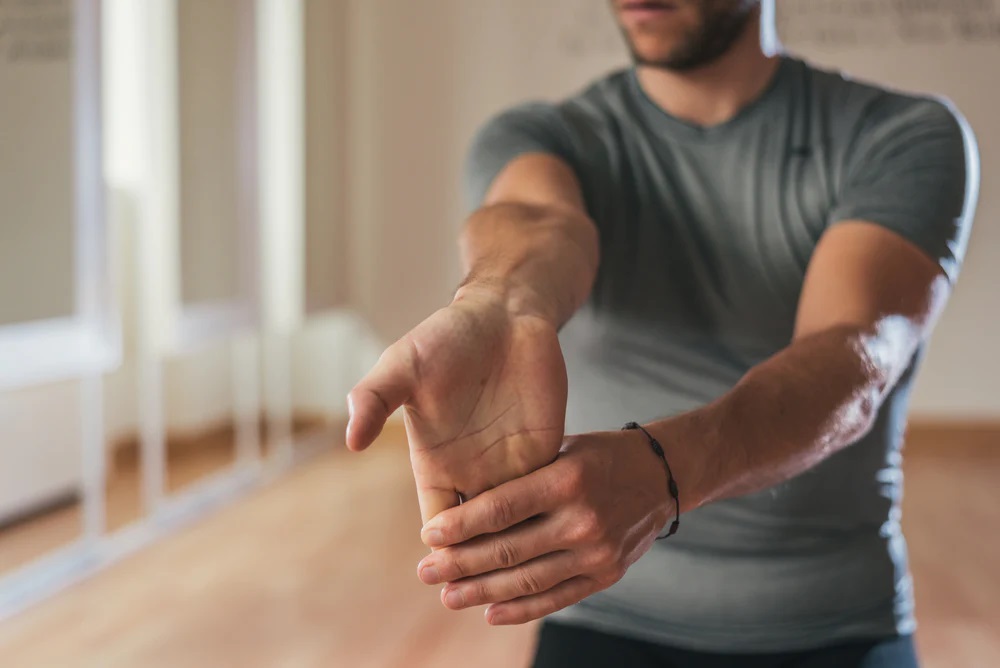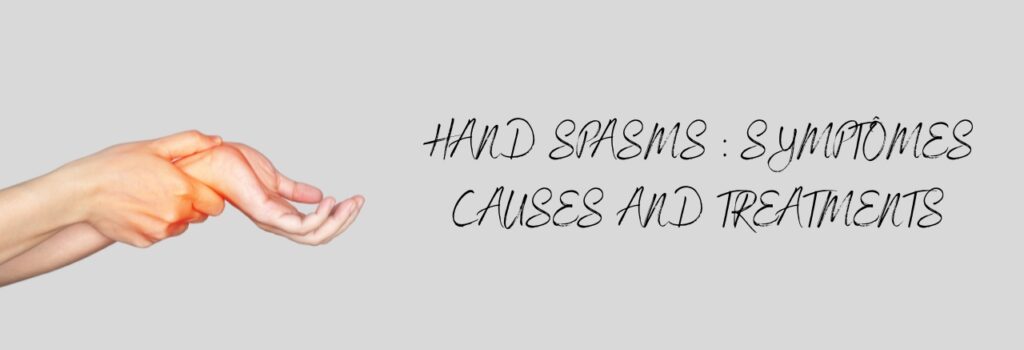Definition of hand spasm
A hand spasm is a sudden and involuntary contraction or tightening of the muscles in the hand, wrist, or fingers. This can cause the affected hand to become stiff, twisted, or locked in a certain position. Hand spasms can be brief or persistent and may be painful or uncomfortable. They can be caused by a variety of factors, including nerve damage, dehydration, muscle fatigue, or neurological conditions such as dystonia or Parkinson’s disease. Treatment options may include medication, physical therapy, or lifestyle changes such as hydration and stress reduction techniques.

type of hand spasm
- Writer’s cramp: This is a type of dystonia that affects the hand and forearm muscles. It can cause involuntary muscle contractions and spasms that interfere with the ability to write or perform other fine motor tasks.
- Carpopedal spasm: This is a type of hand spasm that is caused by a decrease in blood calcium levels. It can cause the muscles in the hand and fingers to contract, leading to pain and stiffness.
- Focal hand dystonia: This is a neurological disorder that affects the muscles of the hand and fingers. It can cause involuntary muscle contractions and spasms, leading to difficulty with fine motor tasks.
- Essential tremor: This is a movement disorder that can cause involuntary shaking or tremors in the hands and other parts of the body.
- Parkinson’s disease: This is a degenerative neurological disorder that can cause muscle rigidity, tremors, and other motor symptoms, including hand spasms.
- Tardive dyskinesia: This is a side effect of certain medications that can cause involuntary muscle movements, including hand spasms.
- Tetany: This is a condition caused by a decrease in blood calcium levels, which can cause muscle spasms and cramping in the hands and other parts of the body.
- Raynaud’s disease: This is a condition that causes narrowing of the blood vessels in the hands, leading to reduced blood flow and hand spasms.
- Dehydration: Dehydration can cause electrolyte imbalances that can lead to muscle cramps and spasms in the hands and other parts of the body.
Treatment for hand spasms depends on the underlying cause. In some cases, lifestyle changes such as reducing stress, staying hydrated, and avoiding trigger activities may be helpful. Medications such as muscle relaxants, botulinum toxin injections, and anticonvulsants may also be prescribed. In severe cases, surgery may be recommended.
causes of hand spasm
There are many possible causes of hand spasms, including:
- Nerve damage: Damage to the nerves in the hand or arm can cause muscle spasms and cramping.
- Dehydration: When the body is dehydrated, it can cause electrolyte imbalances that can lead to muscle cramps and spasms.
- Muscle fatigue: Overuse or fatigue of the muscles in the hand can cause spasms and cramping.
- Electrolyte imbalances: Imbalances in the levels of electrolytes such as calcium, magnesium, and potassium in the body can cause muscle spasms and cramping.
- Neurological conditions: Certain neurological conditions such as dystonia, Parkinson’s disease, and essential tremor can cause hand spasms.
- Medications: Some medications, particularly those used to treat psychiatric conditions, can cause hand spasms as a side effect.
- Raynaud’s disease: This condition causes narrowing of the blood vessels in the hands, leading to reduced blood flow and hand spasms.
- Injuries: Injuries to the hand or arm, such as fractures or sprains, can cause muscle spasms and cramping.
- Autoimmune disorders: Some autoimmune disorders, such as lupus and rheumatoid arthritis, can cause hand spasms as a symptom.
- If you are experiencing hand spasms, it is important to see a healthcare provider for a proper diagnosis and treatment plan.
symptoms of hand spasm
The main symptom of hand spasm is an involuntary and sudden contraction or tightening of the muscles in the hand, wrist, or fingers. Other symptoms that may accompany hand spasms can include:
- Pain or discomfort in the affected hand or fingers
- Stiffness or a feeling of tightness in the affected hand or fingers
- Twitching or jerking movements in the affected hand or fingers
- Difficulty using the affected hand for fine motor tasks such as writing or typing
- Weakness or loss of grip strength in the affected hand
- Shaking or tremors in the affected hand or fingers
- Numbness or tingling in the affected hand or fingers
The severity and duration of symptoms may vary depending on the underlying cause of the hand spasms. If you are experiencing any of these symptoms, it is important to see a healthcare provider for a proper diagnosis and treatment plan.
Using a wrist ice pack can help to alleviate hand spasms by reducing inflammation and pain in the affected area. When applied to the wrist or hand, the cold temperature can help to numb the affected nerves and reduce muscle contractions.
To use a wrist ice pack for hand spasms, first ensure that the affected area is clean and dry. Then, wrap the ice pack in a towel or cloth to protect the skin and prevent frostbite. Apply the ice pack to the affected wrist or hand for 15-20 minutes at a time, several times per day as needed.
It is important to note that while an ice pack can provide temporary relief from hand spasms, it is not a cure for the underlying cause of the spasms. If you are experiencing hand spasms, it is important to see a healthcare provider for a proper diagnosis and treatment plan.
The diagnostic process for hand spasms may involve several steps, including:
Physical examination: A healthcare provider will examine the affected hand or hands and look for any signs of muscle spasms, weakness, or other symptoms.
Medical history: The healthcare provider will ask about the patient’s medical history, including any previous injuries or medical conditions that may be contributing to the hand spasms.
Imaging tests: Depending on the suspected underlying cause of the hand spasms, imaging tests such as X-rays, MRIs, or CT scans may be ordered to examine the affected hand and surrounding structures.
Blood tests: Blood tests may be ordered to check for any electrolyte imbalances or other conditions that may be contributing to the hand spasms.
Nerve conduction studies: In cases where nerve damage is suspected, nerve conduction studies may be ordered to evaluate the function of the nerves in the affected hand.
Once a diagnosis has been made, treatment for hand spasms will depend on the underlying cause. Treatment may involve medications, lifestyle changes, physical therapy, or other interventions to address the root cause of the spasms and alleviate symptoms.
The treatment of hand spasms depends on the underlying cause of the condition. Treatment may include:
Medications: Muscle relaxants or other medications may be prescribed to help alleviate muscle spasms and cramping.
Physical therapy: Stretching and strengthening exercises may be recommended to improve the function of the affected hand and reduce the frequency and severity of spasms.
Lifestyle changes: Making changes to your daily routine, such as taking breaks to rest your hands, improving your posture, or avoiding activities that aggravate your symptoms, may help to reduce the frequency and severity of hand spasms.
Occupational therapy: An occupational therapist can work with you to develop strategies to improve the use of your affected hand for daily tasks.
Surgery: In rare cases, surgery may be recommended to address underlying conditions such as nerve damage or compression.
Alternative therapies: Some people may find relief from hand spasms through complementary therapies such as acupuncture or massage therapy.
It is important to work closely with a healthcare provider to determine the most appropriate treatment plan for your individual needs. They can help to identify the underlying cause of your hand spasms and develop a personalized treatment plan to address your symptoms and improve your overall quality of life.
FAQs:
Q1. Can dehydration cause hand spasms?
A1. Yes, dehydration can cause hand spasms as it leads to an electrolyte imbalance that affects muscle function.
Q2. Can overuse of hand muscles cause hand spasms?
A2. Yes, overuse of hand muscles can cause hand spasms as it leads to muscle fatigue and strain.
Q3. What is the treatment for hand spasms?
A3. Treatment for hand spasms depends on the underlying cause and may include rest and stretching, hydration and electrolyte replacement, vitamin supplements, medications, Botox injections, or surgery.
Q4. Can hand spasms be prevented?
A4. Yes, hand spasms can be prevented by maintaining adequate hydration, proper nutrition, and avoiding overuse of hand muscles.
Q5. When should I see a doctor for hand spasms?
A5. You should see a doctor for hand spasms if they persist, cause pain and discomfort, or difficulty in performing everyday activities.




